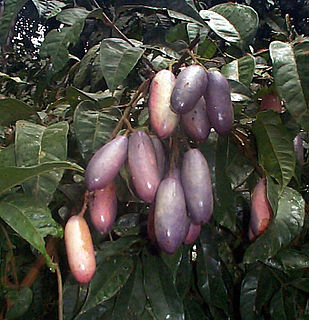
Canarium is a genus of about 100 species of tropical and subtropical trees, in the family Burseraceae. They grow naturally across tropical Africa, south and southeast Asia, Indochina, Malesia, Australia and western Pacific Islands; including from southern Nigeria east to Madagascar, Mauritius, Sri Lanka and India; from Burma, Malaysia and Thailand through the Malay Peninsula and Vietnam to south China, Taiwan and the Philippines; through Borneo, Indonesia, Timor and New Guinea, through to the Solomon Islands, New Caledonia, Fiji, Samoa, Tonga and Palau.
Canarium fuscocalycinum is a tree of Borneo in the incense tree family Burseraceae. The specific epithet fuscocalycinum is from the Latin meaning "dark calyx".
Canarium littorale is a tree found in tropical Asia and is a member of the incense tree family Burseraceae. The specific epithet littorale is from the Latin meaning "of the seashore", referring to its habitat.
Canarium patentinervium is a tree of tropical Asia in the incense tree family Burseraceae. The specific epithet patentinervium is from the Latin meaning "spreading nerves", referring to the leaf veins.
Canarium pseudodecumanum is a tree of tropical Asia in the incense tree family Burseraceae. The specific epithet pseudodecumanum is from the Latin meaning "false decumanum", referring to the species' resemblance to Canarium decumanum.
Canarium pseudopatentinervium is a plant in the incense tree family Burseraceae. The specific epithet pseudopatentinervium is from the Latin meaning "false patentinervium", referring to the species' resemblance to Canarium patentinervium.

Dacryodes is a genus of about 60 species of trees in the family Burseraceae. The generic name is from the Greek dakruon meaning "tear(drop)", referring to how resin droplets form on the bark surface.
Madhuca hirtiflora is a plant in the family Sapotaceae. The specific epithet hirtiflora means "hairy flowers".
Madhuca utilis is a tree in the family Sapotaceae. The specific epithet utilis means "useful", referring to the timber.
Canarium apertum is a tree in the family Burseraceae. The specific epithet apertum is from the Latin meaning "open", referring to the basal openings between petals.
Canarium caudatum is a tree in the family Burseraceae. The specific epithet caudatum is from the Latin meaning "tailed", referring to the tapering of the tree's leaflet.

Canarium decumanum is a tree in the family Burseraceae. The specific epithet decumanum is from the Latin meaning "greatest", referring to the tree's size.
Canarium dichotomum is a tree in the family Burseraceae. The specific epithet dichotomum is from the Latin meaning "forked", referring to the branching of the inflorescences.
Canarium hirsutum is a tree in the family Burseraceae. The specific epithet hirsutum is from the Latin meaning "bristly", referring to the rough hairs of the fruit.
Canarium kinabaluense is a tree in the family Burseraceae. It is named for Mount Kinabalu in East Malaysia's Sabah state.
Canarium latistipulatum is a tree in the family Burseraceae. The specific epithet latistipulatum is from the Latin meaning "wide stipule".
Canarium megalanthum is a tree in the family Burseraceae. The specific epithet megalanthum is from the Greek meaning "large flower".
Canarium merrillii is a tree in the family Burseraceae. It is named for the American botanist Elmer Drew Merrill.
Canarium denticulatum is a tree in the family Burseraceae. The specific epithet denticulatum is from the Latin meaning "small teeth", referring to the leaf margin.
Dacryodes expansa is a tree in the family Burseraceae. The specific epithet expansa is from the Latin meaning "spread out", referring to the structure of the petals.


